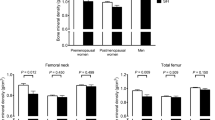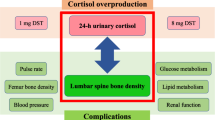Abstract
Summary
Despite ethnic differences in cortisol sensitivity, only one study in Caucasians has assessed trabecular bone score (TBS) in patients with subclinical hypercortisolism (SH). We showed that both subtle cortisol excess and reduced adrenal androgen may contribute to impaired bone quality in Asian women with SH.
Introduction
One study in Caucasians has assessed trabecular bone score (TBS), an index of bone microstructure, in adrenal incidentaloma (AI) patients with subclinical hypercortisolism (SH). There are ethnic differences in cortisol sensitivities between Caucasian and Asian populations. We investigated the associations of cortisol and the adrenal androgen dehydroepiandrosterone-sulfate (DHEA-S) with TBS in AI patients with SH, adrenal Cushing’s syndrome (CS), and nonfunctional AI (NFAI).
Methods
We measured TBS, cortisol levels after the overnight 1 mg dexamethasone suppression test (1 mg DST), and cortisol/DHEA-S in 61 patients with SH (30 men; 31 women), 19 with adrenal CS (4 men; 15 women), and 355 with NFAI (213 men; 142 women).
Results
After adjusting for confounders, the serum cortisol level after 1 mg DST was inversely correlated with TBS in men (β = −0.133, P = 0.045) and women (β = − 0.140, P = 0.048). Higher cortisol/DHEA-S ratio was associated with lower TBS in women (β = − 0.252, P < 0.001), but not men. This inverse association of cortisol/DHEA-S ratio in women remained statistically significant after adjusting for the serum cortisol level after 1 mg DST (β = − 0.221, P = 0.008). Compared with women with NFAI, women with SH had 2.2% lower TBS (P = 0.040). Deteriorated bone microstructure (TBS < 1.230) was associated with the serum cortisol level after 1 mg DST (odds ratio [OR], 2.18; 95% confidence interval [CI], 1.04–4.53) and cortisol/DHEA-S ratio (OR, 2.05; 95% CI, 1.03–4.08).
Conclusions
Subtle cortisol excess in both genders and reduced DHEA-S, especially in women, may contribute to impaired bone quality in Asian patients with SH.

Similar content being viewed by others
References
Fassnacht M, Arlt W, Bancos I, Dralle H, Newell-Price J, Sahdev A, Tabarin A, Terzolo M, Tsagarakis S, Dekkers OM (2016) Management of adrenal incidentalomas: European Society of Endocrinology clinical practice guideline in collaboration with the European network for the study of adrenal tumors. Eur J Endocrinol 175:G1–G34. https://doi.org/10.1530/EJE-16-0467
Chiodini I (2011) Clinical review: diagnosis and treatment of subclinical hypercortisolism. J Clin Endocrinol Metab 96:1223–1236. https://doi.org/10.1210/jc.2010-2722
Chiodini I, Vainicher CE, Morelli V, Palmieri S, Cairoli E, Salcuni AS, Copetti M, Scillitani A (2016) Mechanisms in endocrinology: endogenous subclinical hypercortisolism and bone: a clinical review. Eur J Endocrinol 175:R265–R282. https://doi.org/10.1530/EJE-16-0289
Di Dalmazi G, Pasquali R, Beuschlein F, Reincke M (2015) Subclinical hypercortisolism: a state, a syndrome, or a disease? Eur J Endocrinol 173:M61–M71. https://doi.org/10.1530/EJE-15-0272
Chiodini I, Torlontano M, Carnevale V, Trischitta V, Scillitani A (2008) Skeletal involvement in adult patients with endogenous hypercortisolism. J Endocrinol Investig 31:267–276. https://doi.org/10.1007/BF03345601
Chiodini I, Morelli V, Masserini B, Salcuni AS, Eller-Vainicher C, Viti R, Coletti F, Guglielmi G, Battista C, Carnevale V, Iorio L, Beck-Peccoz P, Arosio M, Ambrosi B, Scillitani A (2009) Bone mineral density, prevalence of vertebral fractures, and bone quality in patients with adrenal incidentalomas with and without subclinical hypercortisolism: an Italian multicenter study. J Clin Endocrinol Metab 94:3207–3214. https://doi.org/10.1210/jc.2009-0468
Morelli V, Eller-Vainicher C, Salcuni AS, Coletti F, Iorio L, Muscogiuri G, Della Casa S, Arosio M, Ambrosi B, Beck-Peccoz P, Chiodini I (2011) Risk of new vertebral fractures in patients with adrenal incidentaloma with and without subclinical hypercortisolism: a multicenter longitudinal study. J Bone Miner Res 26:1816–1821. https://doi.org/10.1002/jbmr.398
Eller-Vainicher C, Morelli V, Ulivieri FM, Palmieri S, Zhukouskaya VV, Cairoli E, Pino R, Naccarato A, Scillitani A, Beck-Peccoz P, Chiodini I (2012) Bone quality, as measured by trabecular bone score in patients with adrenal incidentalomas with and without subclinical hypercortisolism. J Bone Miner Res 27:2223–2230. https://doi.org/10.1002/jbmr.1648
Fu J, Festen EA, Wijmenga C (2011) Multi-ethnic studies in complex traits. Hum Mol Genet 20:R206–R213. https://doi.org/10.1093/hmg/ddr386
Morelli V, Donadio F, Eller-Vainicher C, Cirello V, Olgiati L, Savoca C, Cairoli E, Salcuni AS, Beck-Peccoz P, Chiodini I (2010) Role of glucocorticoid receptor polymorphism in adrenal incidentalomas. Eur J Clin Investig 40:803–811. https://doi.org/10.1111/j.1365-2362.2010.02330.x
Siggelkow H, Etmanski M, Bozkurt S, Grobeta P, Koepp R, Brockmoller J, Tzvetkov MV (2014) Genetic polymorphisms in 11beta-hydroxysteroid dehydrogenase type 1 correlate with the postdexamethasone cortisol levels and bone mineral density in patients evaluated for osteoporosis. J Clin Endocrinol Metab 99:E293–E302. https://doi.org/10.1210/jc.2013-1418
Szappanos A, Patocs A, Gergics P, Bertalan R, Kerti A, Acs B, Feldmann K, Racz K, Toth M (2011) The 83,557insA variant of the gene coding 11beta-hydroxysteroid dehydrogenase type 1 enzyme associates with serum osteocalcin in patients with endogenous Cushing’s syndrome. J Steroid Biochem Mol Biol 123:79–84. https://doi.org/10.1016/j.jsbmb.2010.11.009
Tauchmanova L, Pivonello R, De Martino MC, Rusciano A, De Leo M, Ruosi C, Mainolfi C, Lombardi G, Salvatore M, Colao A (2007) Effects of sex steroids on bone in women with subclinical or overt endogenous hypercortisolism. Eur J Endocrinol 157:359–366. https://doi.org/10.1530/EJE-07-0137
Lee SH, Song KH, Kim J, Park S, Ahn SH, Kim H, Cho YY, Suh S, Kim BJ, Kim JH, Koh JM (2017) New diagnostic criteria for subclinical hypercortisolism using postsurgical hypocortisolism: the co-work of adrenal research study. Clin Endocrinol 86:10–18. https://doi.org/10.1111/cen.13145
McCloskey EV, Oden A, Harvey NC et al (2016) A meta-analysis of trabecular bone score in fracture risk prediction and its relationship to FRAX. J Bone Miner Res 31:940–948. https://doi.org/10.1002/jbmr.2734
Kiel D (1995) Assessing vertebral fractures. National osteoporosis foundation working group on vertebral fractures. J Bone Miner Res 10:518–523. https://doi.org/10.1002/jbmr.5650100403
Genant HK, Wu CY, van Kuijk C, Nevitt MC (1993) Vertebral fracture assessment using a semiquantitative technique. J Bone Miner Res 8:1137–1148. https://doi.org/10.1002/jbmr.5650080915
Heinio L, Nikander R, Sievanen H (2015) Association between long-term exercise loading and lumbar spine trabecular bone score (TBS) in different exercise loading groups. J Musculoskelet Neuronal Interact 15:279–285
Baron RM, Kenny DA (1986) The moderator-mediator variable distinction in social psychological research: conceptual, strategic, and statistical considerations. J Pers Soc Psychol 51:1173–1182
Sobel ME (1982) Asymptotic confidence intervals for indirect effects in structural equation models. Soc Method 13:290–312. https://doi.org/10.2307/270723
Alarkawi D, Bliuc D, Nguyen TV, Eisman JA, Center JR (2016) Contribution of lumbar spine BMD to fracture risk in individuals with T-score discordance. J Bone Miner Res 31:274–280. https://doi.org/10.1002/jbmr.2611
Melton LJ 3rd, Atkinson EJ, O'Connor MK, O'Fallon WM, Riggs BL (1998) Bone density and fracture risk in men. J Bone Miner Res 13:1915–1923. https://doi.org/10.1359/jbmr.1998.13.12.1915
Chiodini I, Viti R, Coletti F, Guglielmi G, Battista C, Ermetici F, Morelli V, Salcuni A, Carnevale V, Urbano F, Muscarella S, Ambrosi B, Arosio M, Beck-Peccoz P, Scillitani A (2009) Eugonadal male patients with adrenal incidentalomas and subclinical hypercortisolism have increased rate of vertebral fractures. Clin Endocrinol 70:208–213. https://doi.org/10.1111/j.1365-2265.2008.03310.x
Harvey NC, Gluer CC, Binkley N et al (2015) Trabecular bone score (TBS) as a new complementary approach for osteoporosis evaluation in clinical practice. Bone 78:216–224. https://doi.org/10.1016/j.bone.2015.05.016
Silva BC, Leslie WD, Resch H, Lamy O, Lesnyak O, Binkley N, McCloskey EV, Kanis JA, Bilezikian JP (2014) Trabecular bone score: a noninvasive analytical method based upon the DXA image. J Bone Miner Res 29:518–530. https://doi.org/10.1002/jbmr.2176
Garnero P, Sornay-Rendu E, Claustrat B, Delmas PD (2000) Biochemical markers of bone turnover, endogenous hormones and the risk of fractures in postmenopausal women: the OFELY study. J Bone Miner Res 15:1526–1536. https://doi.org/10.1359/jbmr.2000.15.8.1526
Ghebre MA, Hart DJ, Hakim AJ, Kato BS, Thompson V, Arden NK, Spector TD, Zhai G (2011) Association between DHEAS and bone loss in postmenopausal women: a 15-year longitudinal population-based study. Calcif Tissue Int 89:295–302. https://doi.org/10.1007/s00223-011-9518-9
Dennedy MC, Annamalai AK, Prankerd-Smith O et al (2017) Low DHEAS: a sensitive and specific test for the detection of subclinical hypercortisolism in adrenal incidentalomas. J Clin Endocrinol Metab 102:786–792. https://doi.org/10.1210/jc.2016-2718
Haden ST, Glowacki J, Hurwitz S, Rosen C, LeBoff MS (2000) Effects of age on serum dehydroepiandrosterone sulfate, IGF-I, and IL-6 levels in women. Calcif Tissue Int 66:414–418
Ohmori N, Nomura K, Ohmori K, Kato Y, Itoh T, Takano K (2003) Osteoporosis is more prevalent in adrenal than in pituitary Cushing’s syndrome. Endocr J 50:1–7
Minetto M, Reimondo G, Osella G, Ventura M, Angeli A, Terzolo M (2004) Bone loss is more severe in primary adrenal than in pituitary-dependent Cushing's syndrome. Osteoporos Int 15:855–861. https://doi.org/10.1007/s00198-004-1616-3
Baulieu EE, Thomas G, Legrain S, Lahlou N, Roger M, Debuire B, Faucounau V, Girard L, Hervy MP, Latour F, Leaud MC, Mokrane A, Pitti-Ferrandi H, Trivalle C, de Lacharriere O, Nouveau S, Rakoto-Arison B, Souberbielle JC, Raison J, le Bouc Y, Raynaud A, Girerd X, Forette F (2000) Dehydroepiandrosterone (DHEA), DHEA sulfate, and aging: contribution of the DHEAge study to a sociobiomedical issue. Proc Natl Acad Sci U S A 97:4279–4284
Nair KS, Rizza RA, O'Brien P, Dhatariya K, Short KR, Nehra A, Vittone JL, Klee GG, Basu A, Basu R, Cobelli C, Toffolo G, Man CD, Tindall DJ, Melton LJ III, Smith GE, Khosla S, Jensen MD (2006) DHEA in elderly women and DHEA or testosterone in elderly men. N Engl J Med 355:1647–1659. https://doi.org/10.1056/NEJMoa054629
Tauchmanova L, Rossi R, Nuzzo V, del Puente A, Esposito-del Puente A, Pizzi C, Fonderico F, Lupoli G, Lombardi G (2001) Bone loss determined by quantitative ultrasonometry correlates inversely with disease activity in patients with endogenous glucocorticoid excess due to adrenal mass. Eur J Endocrinol 145:241–247
Funding
This study was supported by grants from the Asan Institute for Life Sciences, Seoul, Republic of Korea (Project No. 2014-1215) and from the Korea Health Technology R&D Project, Ministry of Health and Welfare, Republic of Korea (Project HI15C0377).
Author information
Authors and Affiliations
Corresponding authors
Ethics declarations
Conflicts of interest
None.
Electronic supplementary material
ESM 1
(DOCX 117 kb)
Rights and permissions
About this article
Cite this article
Kim, BJ., Kwak, M., Ahn, S. et al. The association of cortisol and adrenal androgen with trabecular bone score in patients with adrenal incidentaloma with and without autonomous cortisol secretion. Osteoporos Int 29, 2299–2307 (2018). https://doi.org/10.1007/s00198-018-4608-4
Received:
Accepted:
Published:
Issue Date:
DOI: https://doi.org/10.1007/s00198-018-4608-4




